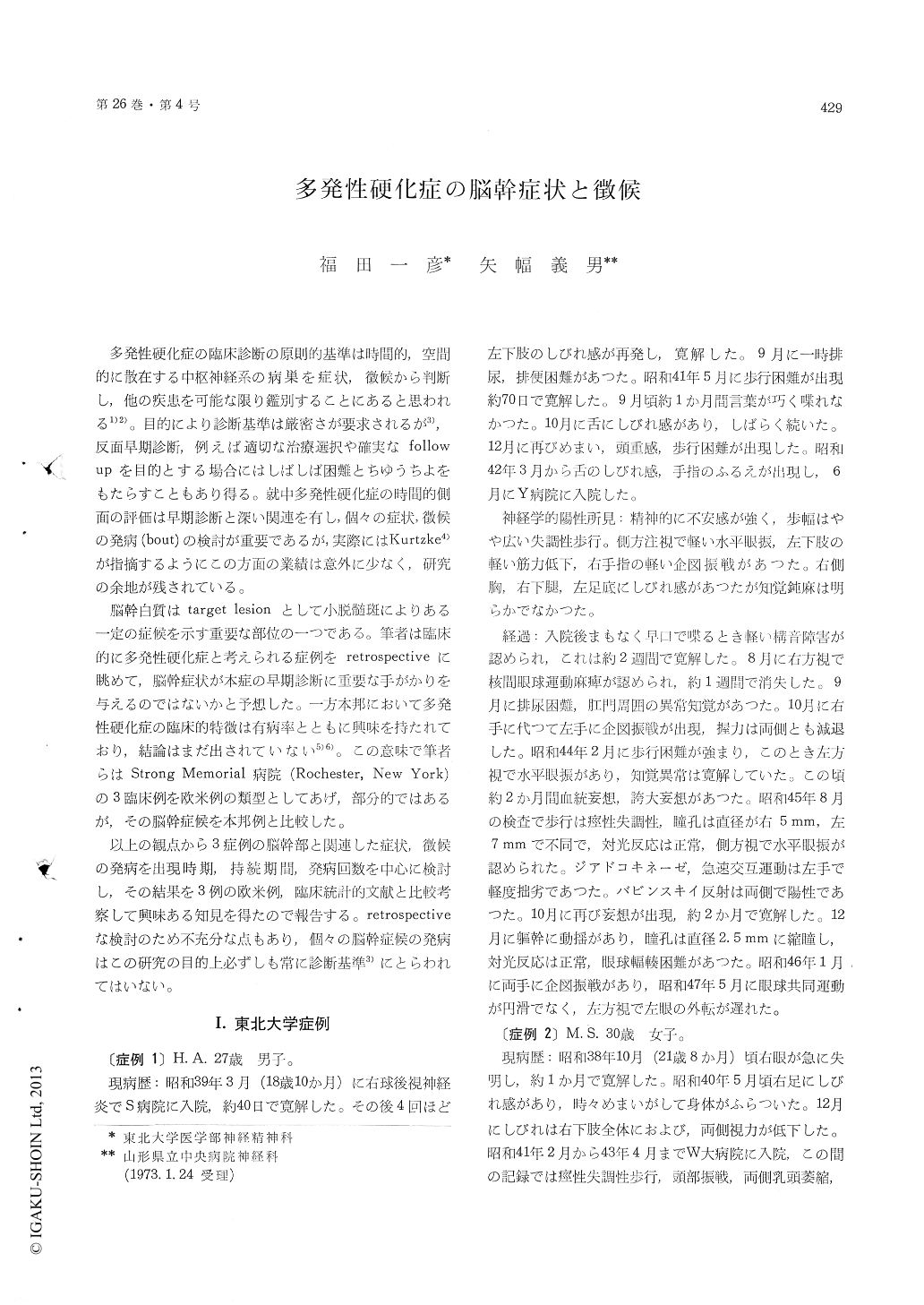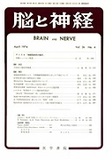Japanese
English
- 有料閲覧
- Abstract 文献概要
- 1ページ目 Look Inside
多発性硬化症の臨床診断の原則的基準は時間的,空間的に散在する中枢神経系の病巣を症状,徴候から判断し,他の疾患を可能な限り鑑別することにあると思われる1)2)。目的により診断基準は厳密さが要求されるが3),反面早期診断,例えば適切な治療選択や確実なfollowupを目的とする場合にはしばしば困難とちゆうちよをもたらすこともあり得る。就中多発性硬化症の時間的側面の評価は早期診断と深い関連を有し,個々の症状,徴候の発病(bout)の検討が重要であるが,実際にはKurtzke4)が指摘するようにこの方面の業績は意外に少なく,研究の余地が残されている。
脳幹白質はtarget lesionとして小脱髄斑によりある一定の症候を示す重要な部位の一つである.筆者は臨床的に多発性硬化症と考えられる症例をretrospectiveに眺めて,脳幹症状が本症の早期診断に重要な手がかりを与えるのではないかと予想した。一方本邦において多発性硬化症の臨床的特徴は有病率とともに興味を持たれており,結論はまだ出されていない5)6)。この意味で筆者らはStrong Memorial病院(Rochester, New York)の3臨床例を欧米例の類型としてあげ,部分的ではあるが,その脳幹症候を本邦例と比較した。
以上の観点から3症例の脳幹部と関連した症状,徴候の発病を出現時期,持続期間,発病回数を中心に検討し,その結果を3例の欧米例,臨床統計的文献と比較考察して興味ある知見を得たので報告する。retrospectiveな検討のため不充分な点もあり,個々の脳幹症候の発病はこの研究の目的上必ずしも常に診断基準3)にとらわれてはいない。
The symptoms and signs relatd to the brain stem of three clinical cases of multiple sclerosis were discussed and three Caucasian cases of multiple sclerosis who were admitted to the Strong Memorial Hospital, Rochester, N. Y. were presented briefly for a partial comparison of brain stem symptoma-tology. Dysarthria, double vision, disturbances of conjugate eye movement, pupillary changes, nystag-mus, paresthesia in the distribution of trigeminal nerve, facial palsy and vertigo were investigated retrospectively with the review of clinicostatistic reports. Conclusions were as follows:
1. Symptoms and signs related to the brain stem may be seen frequently in the early course of the disease. The duration of individual bouts was usually a couple of weeks and they showed complete remission except nystagmus and pupillary change. Nystagmus of complicated nature was more per-sistent than simple horizontal nystagmus on devia-tion. Pupillary change was seen early in a case and seemed to last for a long period in some cases. The frequency of bouts appeared to be less frequent and usually not more than two times.
2. The brain stem symptomatology will give definite clue for the early diagnosis of multiple sclerosis if the prospective examination is adequately performed and thorough follow-up of patients is kept.
3. The case study and review of clinicostatistic literature have suggested that there will be no great difference per se between Caucasian and Japanese cases of multiple sclerosis in terms of the time of onset, duration and remission of brain stem bouts. Though the frequency of bouts ap-peared less frequent in Japanese cases, further in-vestigation will be required.
4. The frequencies of brain stem symptomatology varied markedly with the clinicostatistic reports. The various duration of illness, time of examination and interval between the onset and examination of bouts in materials will be a common cause of it.

Copyright © 1974, Igaku-Shoin Ltd. All rights reserved.


